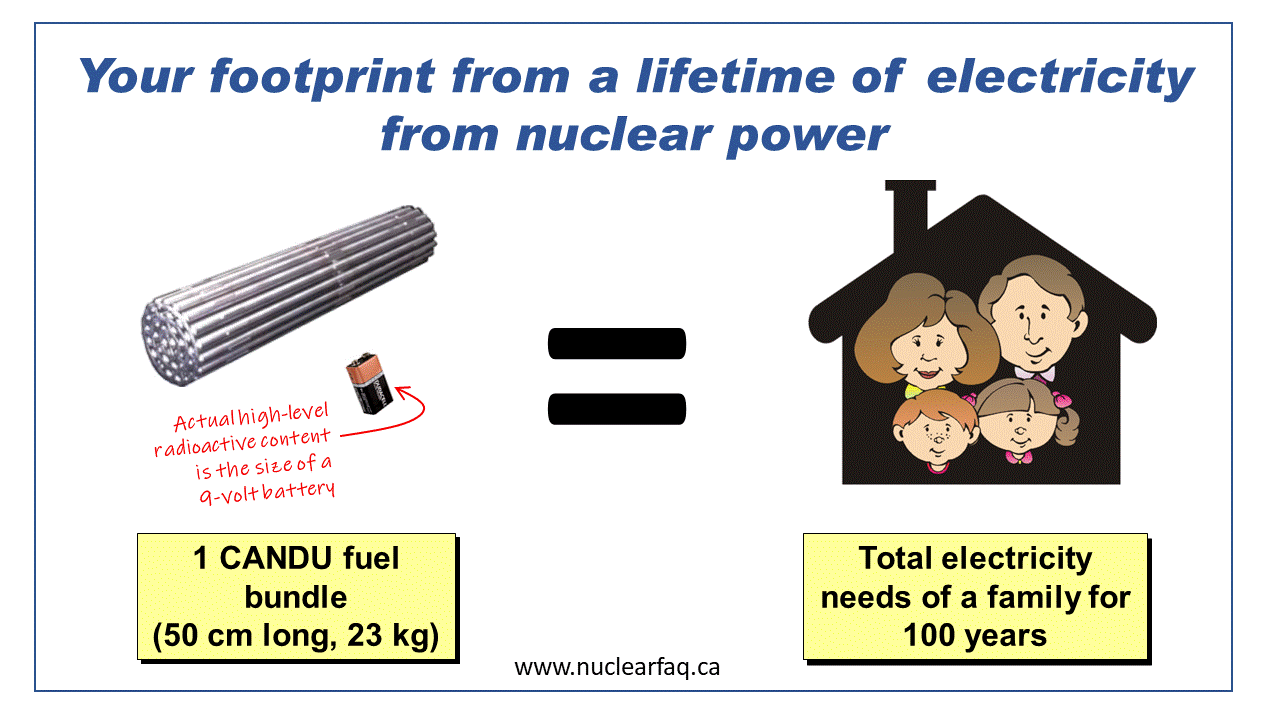The Good News About Nuclear Wasteby Jeremy WhitlockNovember 11, 2021 (published Nov.17, 2021 in the North Renfrew Times)
Your comments are welcome. The important discussions at COP26 this month highlight the folly of developing a global energy infrastructure (fossil fuels) without due consideration for waste management. The nuclear industry can hold its head high in this area: for sustainable energy production nuclear reactors are unmatched, and this extends to the management of their waste products – despite popular conceptions on this controversial topic. Today nuclear power supports a suite of renewable and other energy options that can responsibly power this planet. The chief waste product of nuclear power – its spent fuel – contains all of its most radioactive waste products. Unlike many other industrial processes however, this waste is solid, highly robust, and relatively small. And most importantly: it's all in one place. These are all good things for waste management. Everything makes waste, but – as anyone who has cleaned up after a pet can attest – waste is always more manageable when it's solid, robust, small, and all in one place. Ontario's electricity grid is virtually emissions-free, thanks largely to a fleet of CANDU nuclear reactors operating since 1962. In that time these have generated enough spent fuel, if stacked together, to fill a soccer pitch to the height of a player. That's not a lot of waste from 60 years of anchoring the power grid for Canada's most industrial and populated province. This shouldn't be surprising, since one of the unique advantages of nuclear energy (whether you love it or hate it) is its dazzlingly high energy potential: one CANDU reactor fuel bundle, about the size of a fire log, would meet the electricity needs of an average Ontarian home for 100 years. This roughly 20-kilogram nuclear 'fire log' is equivalent to about 400,000 kilograms of coal (a factor of 20,000 larger), whose combustion would release a million kilograms of greenhouse gases and other pollutants. Even better, this spent CANDU fuel 'fire log', containing all of the high-level radioactive waste from its time in the reactor (the actual amount of this high-level radioactive waste in each fuel bundle is only about 160 grams by the way, or in terms of volume, about the size of a 9V battery), is not only small but also 'on hand' at the reactor facility – available to be dealt with safely and relatively easily: solid, robust, small, and all in one place. These same features make it possible to isolate nuclear spent fuel for the extremely long period of time (thousands of years) that it remains toxic. This duration is longer than civilization has been around, and requires a technology that works with Nature herself, mimicking the methods that she has used to isolate toxic material (radioactive and otherwise) for billions of years (for more on this see my article at www.nuclearfaq.ca/cnf_sectionE.htm#waste confidence). This technology is known as a Geological Repository: a secure 'mine' in reverse, emplacing the spent fuel deep underground in stable rock formations, protected for millennia from external events, seismic activity, multiple glaciations, and all that time protecting the biosphere above it from its own radioactive and chemical toxicity. In fact, since future glaciation will impact most of Canada, including its major cities and industrial sites, it is very likely that the one toxic legacy that future civilizations will not have to worry about will be the used nuclear fuel stored responsibly in these underground repositories. This waste solution is available to us today. It is currently being implemented in Finland, which will soon emplace spent nuclear fuel in the world's first geological repository for this waste form. Many other countries with nuclear programs have developed similar technology, including Canada – which will select a site for its geological repository in the next couple of years (more information on this is available from the Nuclear Waste Management Organization, www.nwmo.ca). And if that weren't enough, it's worth noting that spent nuclear fuel has an additional attractive feature: it still contains about a hundred times the potential energy that was extracted from it during its time in a nuclear reactor, which can be recycled in more advanced reactor technologies under development today. This makes spent nuclear fuel a potential resource for an energy-hungry world, although most countries plan (for now) to meet their ethical responsibility to address this generation's waste legacy today, through safe and secure geological isolation. In the nuclear business we are accustomed to a certain amount of 'waste shaming' directed our way, but there is no shame in the sustainability of nuclear technology, up to and including its waste product. A common allegation is that nuclear power 'has no long-term solution' for its waste, but the facts say otherwise: nuclear power may, in fact, be the ONLY technology on this planet with a true long-term solution for its waste. And that's something we can all be proud of.

|
|
|
